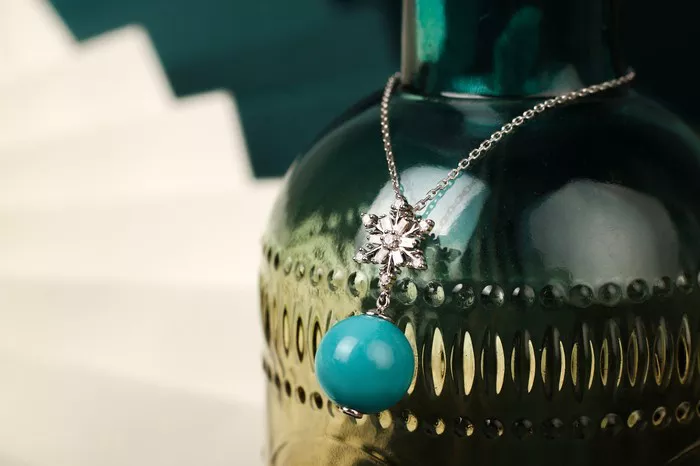Turquoise, with its captivating hues reminiscent of a serene sky, has long held a special place in human history and culture. Beyond its aesthetic appeal, this gemstone is steeped in secrets, myths, and legends that have fascinated civilizations for millennia. In this exploration, we delve into the enigmatic world of turquoise, uncovering the truths behind its allure and the myths that have shrouded it in mystery.
The Origins: Unveiling the Mystical Birth of Turquoise
Turquoise, chemically known as hydrated copper aluminum phosphate, owes its vibrant blue-green color to the presence of copper and iron. Its formation occurs primarily in arid regions where copper-rich groundwater interacts with aluminum and phosphorus minerals over millions of years.
One of the most storied origins of turquoise lies in the ancient mines of the Sinai Peninsula, where it was extracted by the Egyptians as early as 6,000 BCE. Revered as a sacred stone, turquoise adorned the pharaohs and was often placed in burial chambers to protect the deceased in the afterlife.
Another significant source of turquoise is the Southwest United States, particularly in regions such as Arizona, New Mexico, and Nevada, where Native American tribes have revered the stone for its spiritual and cultural significance. The Navajo, Hopi, and Pueblo peoples, among others, incorporated turquoise into their jewelry, pottery, and religious ceremonies, attributing it with protective and healing properties.
See Also: American VS Chinese Turquoise
Myths and Legends: Exploring the Ancient Tales
The Talisman of Protection
Turquoise has been regarded as a talisman of protection across various cultures and civilizations. Ancient Persians believed that wearing turquoise amulets could ward off evil spirits and bring prosperity. Similarly, Native American tribes often adorned infants with turquoise to shield them from harm and ensure their well-being.
The Stone of Communication
In Native American lore, turquoise is associated with clear communication and expression. It is believed that wearing turquoise jewelry can enhance one’s ability to articulate thoughts and emotions, fostering harmonious relationships within communities.
The Healing Gem
Throughout history, turquoise has been valued for its purported healing properties. In ancient Egypt, it was used as a remedy for various ailments, ranging from eye infections to stomach disorders. Similarly, Native American healers relied on turquoise to alleviate physical pain and promote spiritual balance.
The Truth Behind the Myths: Scientific Insights
While the myths surrounding turquoise are deeply ingrained in cultural beliefs, modern science offers valuable insights into its properties and benefits.
Metaphysical Properties
While there is no scientific evidence to support the metaphysical claims attributed to turquoise, its soothing color and calming presence can indeed have psychological effects on individuals. Psychologists suggest that certain colors, including the blue-green hues of turquoise, can evoke feelings of tranquility and relaxation, contributing to a sense of well-being.
Physical Healing
Turquoise contains trace elements of copper, which have antimicrobial properties that may aid in wound healing and reduce inflammation. However, these effects are most pronounced in copper salts rather than in the crystalline structure of turquoise itself. Nevertheless, the historical use of turquoise in traditional medicine underscores its cultural significance as a symbol of healing and protection.
The Turquoise Trade: Commerce and Cultural Exchange
From ancient trade routes to modern markets, turquoise has traversed continents and cultures, leaving a trail of commerce and cultural exchange in its wake. The Silk Road, a network of trade routes connecting East and West, facilitated the exchange of turquoise along with other precious goods such as silk, spices, and precious metals.
During the European Renaissance, turquoise became synonymous with luxury and opulence, adorning the crowns, jewelry, and ceremonial regalia of royalty and aristocracy. Its rarity and exquisite color made it highly coveted among the elite classes, further fueling demand and trade.
In the Americas, turquoise played a central role in indigenous economies and cultural exchange. Native American tribes engaged in intertribal trade networks, exchanging turquoise for goods such as obsidian, shells, and feathers. The Pueblo people of the Southwest crafted intricate turquoise jewelry, which became sought-after commodities among traders and collectors.
Preserving the Legacy: Challenges and Conservation Efforts
Despite its enduring legacy, turquoise faces threats from overexploitation, illegal mining, and environmental degradation. In regions such as the Southwest United States, unregulated mining practices have led to habitat destruction and water pollution, endangering both the natural environment and indigenous communities that rely on turquoise for their livelihoods.
To address these challenges, conservation organizations and government agencies have implemented measures to promote sustainable mining practices and protect turquoise-bearing ecosystems. Initiatives such as the Responsible Jewelry Council and the Turquoise Sustainability Project aim to raise awareness about the ethical and environmental implications of turquoise mining, advocating for responsible sourcing and fair trade practices.
The Legacy Lives On: Turquoise in Contemporary Culture
In the 21st century, turquoise continues to captivate artists, designers, and collectors with its timeless beauty and cultural significance. Fashion designers incorporate turquoise into their collections, while interior designers use it to add a touch of elegance and tranquility to living spaces.
Moreover, turquoise remains a symbol of cultural identity and pride for indigenous communities, who continue to preserve traditional craftsmanship techniques and revitalize their artistic heritage. Organizations such as the Southwestern Association for Indian Arts and the Indigenous Jewelry Initiative support Native American artisans and promote the ethical sourcing of turquoise and other indigenous materials.
Conclusion
In conclusion, turquoise transcends its status as a mere gemstone, embodying centuries of history, mythology, and cultural significance. From the ancient civilizations of Egypt and Persia to the indigenous peoples of the Americas, turquoise has left an indelible mark on human culture and consciousness.
As we unravel the secrets, myths, and legends surrounding turquoise, we gain a deeper appreciation for its enduring beauty and spiritual resonance. Whether as a symbol of protection, a conduit for communication, or a source of healing, turquoise continues to inspire awe and reverence across cultures and generations.
As we cherish and preserve this precious legacy, let us honor the timeless charm of turquoise and the profound connections it fosters between humanity and the natural world.


